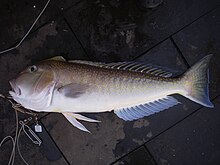Great northern tilefish
| Great northern tilefish | |
|---|---|
 |
|
| Scientific classification | |
| Kingdom: | Animalia |
| Phylum: | Chordata |
| Class: | Actinopterygii |
| Order: | Perciformes |
| Suborder: | Percoidea |
| Family: | Malacanthidae |
| Genus: | Lopholatilus |
| Species: | L. chamaeleonticeps |
| Binomial name | |
|
Lopholatilus chamaeleonticeps Goode & T. H. Bean, 1879 |
|
 |
|
The great northern tilefish (Lopholatilus chamaeleonticeps), or golden tile, is the largest species in the family Malacanthidae (tilefishes), which grows to an average length between 38 and 44 inches (970 and 1,120 mm). The great northern tilefish is a slow-growing and long-lived species, which has four stages of life. After hatching from eggs, the larvae will be found in plankton. As they grow into juveniles, the individuals will seek shelter until finding or making their own burrows. As adults, the tilefish will continue to expand its burrow in the sediment throughout its life. The diet of the larvae is unknown, but presumed to consist of zooplankton; juveniles and adults feed upon various benthic invertebrates, crustaceans and fish. After reaching sexual maturity between 5 and 7 years of age, females will lay eggs throughout the mating season for the male to fertilize, with each female laying an average of 2.3 million eggs.
The great northern tilefish has been subject to regulation to prevent overfishing. Regulations include catch limits and gear restrictions to prevent damage to the species' habitat and population. The result of these regulations has seen a rebounding of the population, which led to an increase in the 2012 catch limit in the southern part of the Atlantic seaboard.
The species was first discovered in 1879, when a cod trawler caught some by chance while working off of the coast of Massachusetts. The species was named Lopholatilus chamaeleonticeps by George Brown Goode and Tarleton Hoffman Bean in 1896 in their seminal work Oceanic Ichthyology, A Treatise on the Deep-Sea and Pelagic Fishes of the World, from a sample collected 80 miles (130 km) south east of Nomans Land, Massachusetts. Its genus is Lopholatilus, which itself is in the family Malacanthidae, commonly known as tilefish. The Malacanthidae are part of the Percoidea, a suborder of the order Perciformes.L. chamaeleonticeps gained its moniker "great northern tilefish" from its prodigious size and its discovery at relatively high latitudes for a member of Malacanthidae. When used in cooking, the species is generally referred to as the "golden tile", for the large yellow spots across its blue-green back and lighter-yellow or pink sides. The species is distinguished from other members of their large family by a prominent crest on their head.
...
Wikipedia

